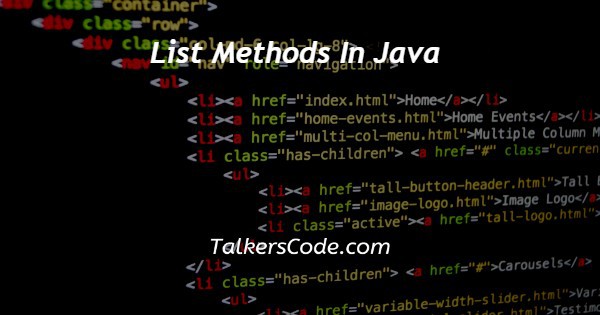In this article we will show you the solution of list methods in java, an ordered collection can be stored using Java's List interface. There is the possibility of storing duplicate values in this ordered collection of objects.
In Lists, elements can be accessed and inserted positionally since their insertion order is preserved.
The List interface is featured in the java.util package and inherits from the Collection interface.
There is a factory in this class that implements the ListIterator interface.
Using the ListIterator, we can iterate the list in a forward and backward direction.
The List interface has four implementation classes: ArrayList, LinkedList, Stack, and Vector.
The Java programming language makes extensive use of ArrayLists and LinkedLists.
We will now discuss the idea of how to list methods in java with an example.
Step By Step Guide On List Methods In Java :-
// Java Program to Remove Elements from a List
// Importing List and ArrayList classes
// from java.util package
import java.util.ArrayList;
import java.util.List;
// Main class
class TC {
// Main driver method
public static void main(String args[])
{
// Creating List class object
List<String> al = new ArrayList<>();
// Adding elements to the object
// Custom inputs
al.add("Talkers");
al.add("Talkers");
// Adding For at 1st indexes
al.add(1, "Code");
// Print the initialArrayList
System.out.println("Initial ArrayList " + al);
// Now remove element from the above list
// present at 1st index
al.remove(1);
// Print the List after removal of element
System.out.println("After the Index Removal " + al);
// Now remove the current object from the updated
// List
al.remove("Code");
// Finally print the updated List now
System.out.println("After the Object Removal "
+ al);
}
}
- Our first step is to import the ArrayList and List classes from the java.util package.
- As a first step, we define a class named "TC".
- Defining the main method in the class is the last step.
- ArrayList implementation is used to create an object of the List class, and the .add() method is used for adding elements to it.
- In this example, we use a print statement to print out the initial arraylist.
- In this case, we use the .remove() method to remove the element at the 1st index.
- A print statement is used again to display the updated ArrayList.
- In the following example, we will remove the element "Code" from the array list by using the method .remove().
- In the final step, we use a print statement to display the updated ArrayList.
Conclusion :-
As a result, we have successfully learned how to list methods in java with an example.
There are some parts of the Java language that are slightly intimidating, including the collections framework.
In addition to being a powerful Java language feature, it also contains a few of the most interesting techniques! Array Lists are very powerful due to the fact that they reduce the amount of work needed by the developer.
When you add data to objects of this class, they expand automatically and in an efficient manner.
A good example of how automatic expansion helps is to prevent issues such as exceeding an array's boundaries.
I hope this article on list methods in java helps you and the steps and method mentioned above are easy to follow and implement.














